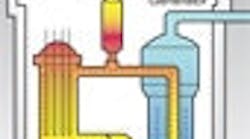“Ask the Experts” is moderated by Béla Lipták, process control consultant and editor of the Instrument Engineer’s Handbook (IEH). Preparation of IEH’s 5th edition will start shortly. If you’re qualified to update an existing chapter or prepare a new one, please sent your resumé. Similarly, if you’d like to ask or help answer questions in this column, write to [email protected].
Q: Our factory has a MagFlow flowmeter from Emerson Process Management to measure sugar juice. Sensor model is 8711SSA040R1N0 and transmitter model is 8732CR12N0M4.
After one season’s operation, the flowmeter failed. The error message is “reverse flow,” and in the transmitter, the indicator number keeps counting the flow, although the pipe is empty. We check all the parameters and the same thing occurs. Then we do calibration, but the situation does not improve.
When we take the sensor out of the pipe, it seems to be OK—no error message appears on the display, and the transmitter display/indicator is not counting. When we reinstall it in the pipeline, the same error message appears. The ground/earth wire is OK.
Please help me to solve problem and/or find out the root cause of it, or do we have to replace with a new sensor?
A: This phenomenon is typical of both AC and DC magnetic flowmeters. When nothing seems to be wrong with the sensors or the transmitter and yet this occurs, check the integrity of the electrode seal within the pipe or the integrity of the lining, if any. Faraday’s Law never ceases to function as long as the fluid is in contact with the electrodes, even if the pipe is only half full. When the liquid sloshes, the meter can give a negative reading.
I recommend checking the grounding of orifices on both sides if the pipe is lined. Magnetic flowmeters often ground the output signal to minimum when flow drops to zero or to a known low point, thus avoiding these kind of erroneous readings.
G.”Ram”Ramachandran
Systems Research International Inc.
A: If the meter operates properly when removed from the line, and it does not when installed, the problem is caused by an installation error.
The voltage which the magnetic flowmeter detects is induced by the velocity of the flowing conductive fluid. Because this voltage is very small, ANY extraneous voltage or electric noise will interfere with it. Consequently, the electrodes must be well-insulated from the pipe if the pipe is conductive (metallic). This insulation will fail if:
- the electrodes come into contact with the pipe, because the electrode seals are damaged,
- the flowing fluid contacts the pipe because the meter lining is damaged or
- the bonding of the meter (or its ground) has failed, and therefore, the electrically conductive pipeline is no longer grounded.
My guess is that your trouble is caused by bad bonding.
Figure 1. A typical nuclear power plant arrangement.
Q: Hungary has a national nuclear power plant, MVM Paks NPP. Our company is interested in the NPP’s intrumentation and control-related reconstruction work. It has to be done by late 2012. I have to choose and test some software systems with the following requirements:
- We would like to eliminate the very different and complex designing and drawing processes and integrate them into a package.
- The software must allow us to make functional and logical plans (I think P&ID is also necessary). In addition, we would like to generate other design documents, such as electrical, control and plant drawings. At least we would like to learn about the main differences between the available software packages on the market. We need to do this to help preventing operators from making avoidable errors. So we would like to automate almost everything.
- We would like to test (dynamically, animated) the whole plant. (Actually we have the complete system in FORTRAN. It is a fully detailed model, working as the operating plant, but I am not sure if our operating software is compatible with the new software packages. Maybe we can make adjustment and modifications to eliminate the conflicts if we know their database structure.
- It is a must to have an interface with DCS systems, which in our case is Siemens SPPA-T3000.
- Because our high expectations, we would like either select an existing software package for this purpose or develop the software needed ourselves.
What kind of products or product packages can you recommend? The only suitable packages I’ve found are an Invensys and a Comos system combined into a package, but I think they do not have interfaces to Siemens.
Balint Katona, Software Engineer
A: I am glad that the controls at the Paks nuclear power plant, (which was completed in 1974, placed on line in 1982 and experienced an accident in 2003) will be updated. After over 25 years of operation, it is high time. For the safety controls needed, refer to my series of articles at www.controlglobal.com/voices/liptak.html.
As to displays, we usually start with a dynamic process display, such as the one below and add all the monitoring, logic and control instrumentation, including details such as transmitter ranges, tuning settings, valve failures, etc., to that. Next, we provide the operators with means to first view the conditions of the total plant and after that to focus on any area of interest and observe the operation of any control loop or safety interlock, etc.
In my July article on nuclear safety, I will describe the causes of the Chernobyl accident. Because the Paks plant in some ways is similar to that one, you should make sure to eliminate the control errors that I will list. You should also keep in mind the emerging threat of cyberterrorism, which I discussed in an article you can read at www.controlglobal.com/voices/liptak.html. The bottom line is that you should eliminate all communication links between plant controls and the Internet. Another emerging threat you have to protect against is in the areas of spent fuel storage and reprocessing, because 20 pounds of platinum is enough to build a dirty bomb.
You should also think about recovering the waste heat from condensers, etc. and use it to heat the city of Paks.
As to the Invensys and Comos packages, I was under the impression that they have the capability to interface with Siemens, but I am not absolutely sure of that. I suggest that you check with a software expert at Siemens or with somebody like James K. Bigelow, principal simulation engineer at Pacific Gas & Electric Company.
For a drawing of the magnetic flowmeter problem described in Question 1, go to www.controlglobal.com/0902_ATE.html.



